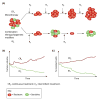The Genetic/Non-genetic Duality of Drug 'Resistance' in Cancer
- PMID: 29458961
- PMCID: PMC5822736
- DOI: 10.1016/j.trecan.2018.01.001
The Genetic/Non-genetic Duality of Drug 'Resistance' in Cancer
Abstract
Drug resistance is a serious impediment to the treatment of cancer. However, the mechanisms involved remain poorly understood. While it is widely held that the phenomenon is genetic in nature, emerging evidence suggests that non-genetic mechanisms may also be important. Furthermore, at least in some cases, refractoriness to treatment can be reversed by epigenetic reprogramming, and combination and intermittent therapies, as opposed to sustained monotherapy, appear more effective in attenuating it. Here we iterate the confusion in understanding the phenomenon by which cancer cells evade drug response and underscore the need to recognize the genetic/non-genetic duality of drug resistance in cancer. We discuss how ecological and evolutionary principles may help to reconcile the duality and may even offer new treatment strategies.
Keywords: cancer; drug resistance; duality; epigenetic mechanism; intermittent therapy.
Copyright © 2018 Elsevier Inc. All rights reserved.
Conflict of interest statement
Figures



References
-
- Santa-Maria CA, Gradishar WJ. Changing Treatment Paradigms in Metastatic Breast Cancer: Lessons Learned. JAMA Oncol. 2015;1:528–34. - PubMed
Publication types
MeSH terms
Grants and funding
LinkOut - more resources
Full Text Sources
Other Literature Sources

